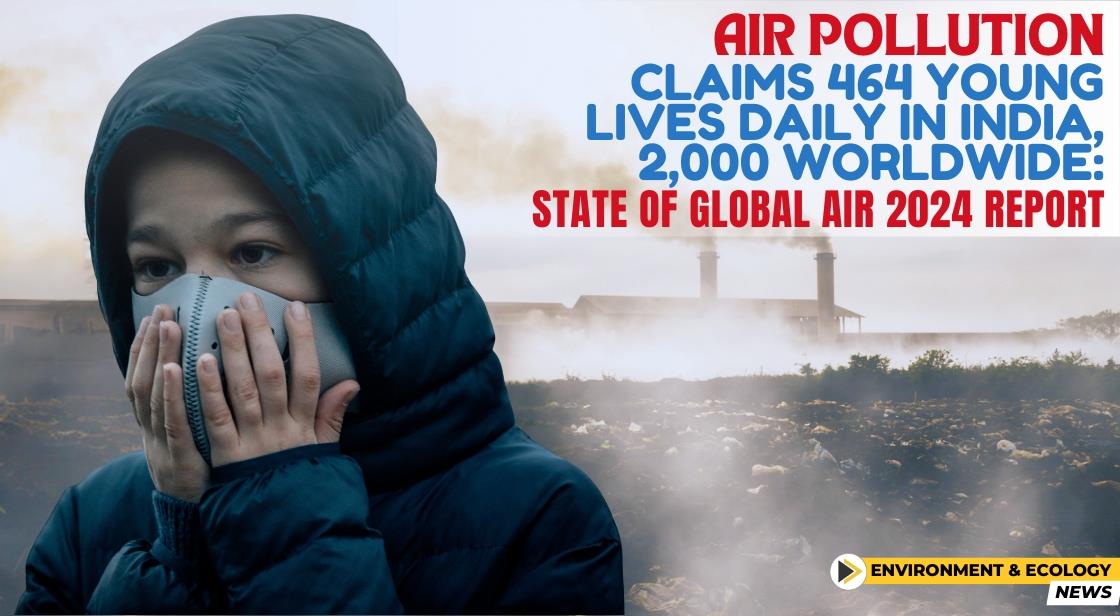Air Pollution Claims 464 Young Lives Daily in India, 2,000 Worldwide: State of Global Air 2024 report

News Synopsis
A recent report by the Health Effects Institute (HEI) and UNICEF paints a grim picture: air pollution is now the second leading cause of death globally, following closely behind high blood pressure. This silent threat is particularly devastating for children, with the "State of Global Air 2024" report highlighting that air pollution claims the lives of nearly 464 children under five in India each day, and a staggering 2,000 young lives worldwide. This surpasses both poor sanitation and inadequate clean water as the top environmental health risk for children.
Air Pollution: A Silent Threat Claiming Young Lives
The Deadly Toll of PM2.5 Particles
The report identifies PM2.5, fine particulate matter less than 2.5 micrometers in diameter, as the primary culprit. These microscopic particles infiltrate the bloodstream, impacting vital organs and contributing to a range of health issues, including lung and heart diseases, diabetes, and even dementia. Shockingly, over 90% of air pollution-related deaths globally are attributed to PM2.5.
Disparities and Generational Impact
The State of Global Air 2024" report underscores the severe disparities in the burden of air pollution. Lead author Pallavi Pant, head of global health at HEI, emphasizes, "Far too much of the burden [is] borne by young children, older populations, and low and middle income countries." This highlights the need for targeted solutions that address these inequalities and protect vulnerable populations.
Beyond Children's Health: A Link to Climate Change
The report doesn't stop at the immediate health impacts on children. It also establishes a concerning link between worsening air quality and the climate crisis. Events like severe droughts, wildfires, and dust storms exacerbate air pollution by releasing harmful particles that persist in the atmosphere, further jeopardizing global health outcomes. Melting glaciers and permafrost due to rising temperatures can also release trapped pollutants, creating additional threats.
A Vicious Cycle: Air Pollution and Climate Change
The report identifies a vicious cycle at play. Air pollution itself can contribute to climate change. Pollutants like black carbon trap heat in the atmosphere, accelerating global warming. This, in turn, leads to more extreme weather events that worsen air quality, creating a feedback loop with detrimental consequences.
Investing in Clean Air for a Healthier Future
Despite the challenges, the report emphasizes the need for immediate action. An estimated 2.3 billion people globally still lack access to clean cooking fuels. The International Energy Agency estimates an annual investment of $4 billion is needed by 2030 to address this issue, particularly in sub-Saharan Africa. Investing in clean air solutions not only saves lives but also contributes to a healthier planet, highlighting the interconnectedness of environmental and human health.
Multi-pronged Approach: Solutions for Cleaner Air
The report calls for a multi-pronged approach to tackle air pollution. Here are some key areas for action:
-
Regulation and Enforcement: Implementing stricter regulations on industrial emissions and vehicle exhausts is crucial. Additionally, enforcing existing regulations effectively is essential to ensure polluters are held accountable.
-
Renewable Energy Transition: Shifting towards renewable energy sources like solar and wind power can significantly reduce air pollution from fossil fuel combustion.
-
Sustainable Transportation: Promoting electric vehicles, cycling, and improved public transportation can significantly reduce traffic-related air pollution in urban areas.
-
Clean Cooking Solutions: Providing access to cleaner cooking fuels and technologies, such as biogas or solar cookstoves, can dramatically improve indoor air quality, especially in low- and middle-income countries.
-
Public Awareness: Educating the public about the health risks of air pollution and empowering them to make informed choices that contribute to cleaner air is vital for long-term progress.
By implementing these solutions, we can create a future where children and all people can breathe clean air and live healthy lives.
You May Like









